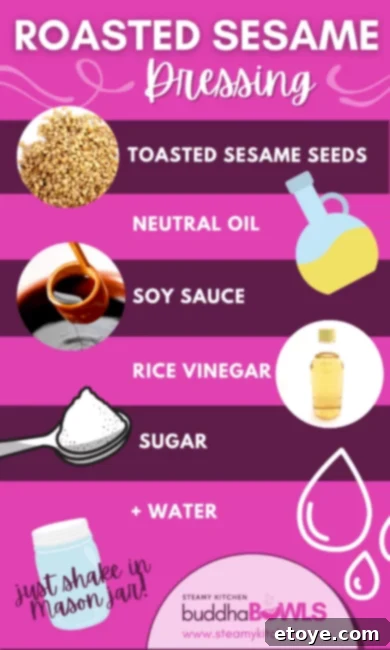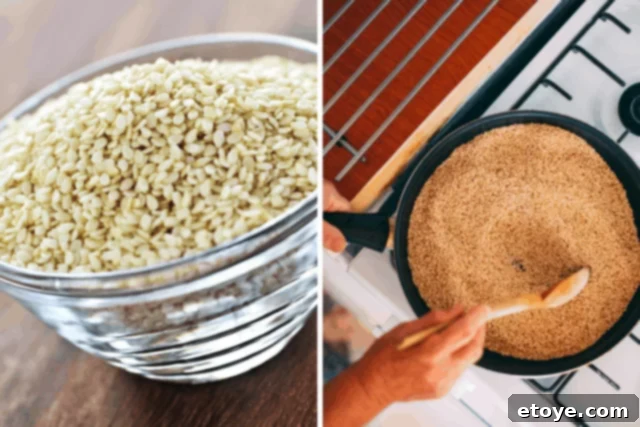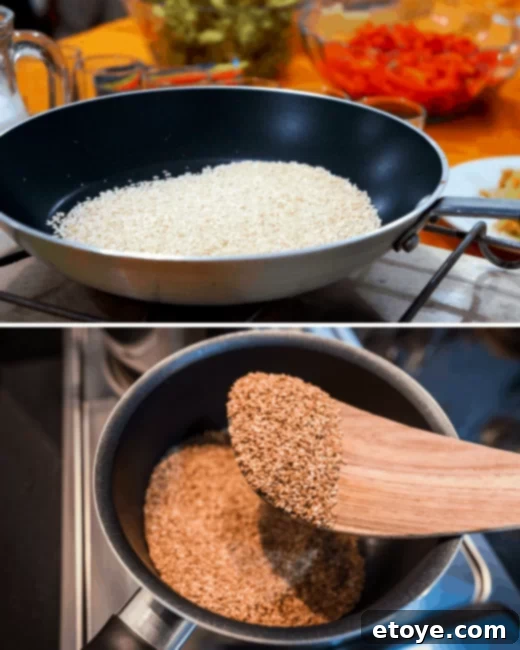Transform your meals with this incredibly easy, sweet, and creamy homemade roasted sesame dressing. Starting with freshly toasted sesame seeds unlocks an aroma and flavor that’s simply irresistible!

Experience the Magic: How to Make the Best Homemade Roasted Sesame Dressing
Prepare for a culinary revelation that will forever change your perception of salad dressings. This homemade roasted sesame dressing isn’t just a simple condiment; it’s a vibrant symphony of sweet, creamy, and deeply savory flavors that promises to awaken your palate and transform any dish it graces. Forget the lackluster, often overly sweet or artificial store-bought versions. Once you experience the unparalleled freshness and profound depth of flavor achieved by making your own, there will be no turning back. It’s surprisingly easy to prepare, yet delivers such an impactful and complex taste that it will truly knock your socks off, earning a permanent spot in your recipe rotation.
The secret to its unforgettable taste lies in one crucial step: toasting the sesame seeds yourself. This simple process unlocks a hidden world of nutty aromas and rich flavors that are simply not present in raw seeds or many pre-made dressings. From crisp green salads to hearty grain bowls, and even as a delightful marinade, this versatile dressing is about to become your new favorite kitchen staple.
Why Homemade Roasted Sesame Dressing Is a Game-Changer
In a world overflowing with convenience, why bother making dressing from scratch? The answer lies in control, flavor, and health. Homemade roasted sesame dressing offers distinct advantages that bottled versions simply cannot match:
- Unrivaled Freshness: The most significant difference is the freshness. When you toast sesame seeds and blend them into a dressing, the vibrant, nutty aromas and flavors are at their peak. Store-bought dressings, by necessity, contain preservatives and often sit on shelves for months, losing much of their intrinsic appeal.
- Control Over Ingredients: Making your own means you dictate exactly what goes in. No unwanted artificial flavors, colors, or high-fructose corn syrup. You can opt for organic ingredients, choose your preferred type of oil, and adjust the sodium and sugar content to suit your dietary preferences or health goals. For instance, using low-sodium soy sauce significantly reduces the overall saltiness without sacrificing the essential umami flavor.
- Customizable Flavor Profile: Do you like it a little sweeter? A bit tangier? More savory? With a homemade recipe, you can easily fine-tune the balance of sweet, sour, salty, and umami to perfectly match your taste buds. This level of customization is impossible with pre-bottled options.
- Cost-Effective: While high-quality store-bought dressings can be expensive, the ingredients for this homemade version are common pantry staples that are generally inexpensive. A bag of raw sesame seeds goes a long way, offering fantastic value for money.
- A Sense of Accomplishment: There’s an undeniable satisfaction in creating something delicious from scratch. This dressing is not only flavorful but also simple enough for even novice cooks to master, providing a rewarding culinary experience.
Embracing the homemade approach to salad dressings, especially this roasted sesame variety, is a small change that yields big results in terms of taste, health, and culinary enjoyment.
The Simple Ingredients Behind an Extraordinary Dressing
One of the most delightful aspects of this roasted sesame dressing recipe is its short and accessible ingredient list. Despite their simplicity, these few components come together in perfect harmony to create a dressing that is complex, satisfying, and utterly delicious. Before you begin, gather these pantry heroes:

- Sesame Seeds: These tiny powerhouses are the true star of our dressing. While you can opt for pre-toasted sesame seeds for convenience, toasting raw seeds yourself is highly recommended. It deepens their flavor, releasing a profound nutty aroma that is the hallmark of a truly great roasted sesame dressing.
- Neutral Oil or Japanese Mayonnaise: This ingredient dictates the richness and creaminess.
- For a Creamier Dressing: To achieve a lusciously thick and creamy texture, similar to the beloved Kewpie’s classic creamy roasted sesame dressing, Japanese mayonnaise is your top choice. Its unique richness and slight sweetness provide an incredible base. You won’t regret the indulgence!
- For a Lighter Dressing: If you prefer a lighter consistency or want to control the fat content, a neutral-flavored oil like canola, grapeseed, sunflower, or vegetable oil works perfectly. These oils blend smoothly and allow the sesame flavor to shine.
- Low Sodium Soy Sauce: Essential for infusing the dressing with its characteristic umami depth and a foundational savory flavor. Using a low-sodium variety allows you to adjust the seasoning to your preference without making the dressing overly salty, contributing to a healthier profile. For a gluten-free option, tamari is an excellent substitute.
- Sugar: A crucial component for balancing the savory and tangy elements. Just a touch of sugar enhances the overall flavor profile, adding a delightful hint of sweetness that rounds out the dressing. You can also experiment with honey or maple syrup for a different kind of sweetness.
- Rice Vinegar or Apple Cider Vinegar: These vinegars provide the essential tang and acidity that brightens the dressing and cuts through its richness. Rice vinegar is a staple in Asian cuisine, offering a milder, slightly sweet acidity. Apple cider vinegar can be used for a slightly sharper, fruitier tang. Both work wonderfully, so choose what you have on hand or prefer.
- Salt: A pinch of salt is vital for bringing all the flavors into harmony and enhancing their individual notes. Always taste and adjust to ensure perfect seasoning.
- Water: This is used to achieve the ideal pourable consistency. It helps to thin the dressing to your desired thickness, ensuring it coats salads beautifully without being too heavy.
While convenience products like pre-toasted sesame seeds or ready-made toasted sesame oil are available, the truly superior flavor comes from starting with raw seeds and toasting them yourself. The small effort yields enormous rewards in taste and aroma, making it a step well worth taking for any culinary enthusiast.
Mastering the Art of Toasting Sesame Seeds for Unparalleled Flavor
This is arguably the most critical step in creating a truly outstanding roasted sesame dressing. Toasting raw sesame seeds transforms them from pale, subtly flavored grains into aromatic, golden powerhouses of nutty goodness. The difference in depth of flavor and fragrance is profound, and the process itself is wonderfully simple and quick.

As depicted above, raw sesame seeds (left) are unassuming in both color and taste. But just a few minutes of gentle heat will turn them into the glorious, flavorful gems (right) that are essential for our dressing. The aroma that fills your kitchen during this process is a delightful preview of the rich flavors to come.
Your Step-by-Step Guide to Perfectly Toasted Sesame Seeds:
- Choose the Right Pan: Select a dry, medium to large skillet or frying pan. A non-stick pan works well, but any pan will do. The key is to have enough surface area so the seeds can spread out in a thin, single layer. This ensures even heating and prevents steaming.
- Preheat with Care: Place the pan over medium heat. Allow it to heat up gradually and evenly. You want a consistent temperature across the entire surface to avoid hot spots that can burn the seeds. A good test is to flick a tiny drop of water onto the pan; if it sizzles and evaporates quickly, it’s ready.
- Add the Seeds: Pour your raw sesame seeds into the hot pan, spreading them into an even, single layer. If you’re toasting a large quantity, work in batches. Overcrowding the pan can lead to uneven toasting and prevent the seeds from browning properly.
- Constant Movement is Crucial: Sesame seeds can go from perfectly golden to burnt in a blink of an eye. This is not the time to step away from the stove! Continuously stir the seeds with a wooden spoon or spatula, or gently shake the pan back and forth, to ensure every seed is evenly exposed to the heat.
- Observe and Smell: Keep a close watch on their color. They will gradually transition from a pale off-white to a beautiful golden brown. Simultaneously, a wonderful, nutty aroma will begin to emanate from the pan. This fragrant scent is your primary indicator that they are developing their desired flavor.
- Timing is Everything: This entire process typically takes about 3 to 5 minutes. The exact time depends on your stove’s heat and the thickness of your pan. Err on the side of caution; a slightly lighter toast is better than a bitter, burnt one.
- Immediate Transfer: As soon as the seeds reach a uniform golden-brown color and release their full aroma, immediately remove the pan from the heat and transfer the toasted sesame seeds to a cool plate or bowl. Do not leave them in the hot pan, as residual heat will continue to cook them and can quickly lead to burning. Spreading them out on a cool surface helps them cool down quickly and stops the toasting process.

And just like that, you’ve transformed simple raw seeds into a flavorful foundation for your dressing! If you find yourself with extra toasted sesame seeds, allow them to cool completely before storing them in an airtight container or spice bottle. They are excellent for sprinkling on dishes, adding to stir-fries, or even as a coating for various proteins. Having a jar of perfectly toasted sesame seeds in your pantry is a true culinary asset!
Blending for Creamy Perfection: Assembling Your Dressing
With your sesame seeds expertly toasted and cooled, the final exciting step is to bring all the ingredients together to create that signature creamy texture and perfectly balanced flavor. This process is quick and simple, thanks to the efficiency of modern kitchen tools.
- Initial Blitz of Sesame Seeds: Carefully transfer all your freshly toasted sesame seeds into the bowl of a food processor or a high-speed blender. Give them a quick pulse or blitz for a few seconds. The goal here is to break them down slightly, releasing their flavorful oils and creating a coarse, nutty meal. This initial step ensures a smoother final dressing.
- Combine All Ingredients: Now, add the remaining dressing ingredients to the food processor or blender: the neutral oil (or Japanese mayonnaise), low sodium soy sauce, sugar, rice vinegar, salt, and water.
- Process Until Smooth: Secure the lid and process the mixture until it becomes wonderfully smooth and creamy. Allow the machine to run for about 1-2 minutes, or until all the sesame seeds are finely ground and fully incorporated into the liquids. You may need to pause occasionally to scrape down the sides of the bowl or blender to ensure everything is thoroughly combined. The dressing should be thick enough to cling to a spoon, yet still pourable.
- Adjust Consistency (and Flavor!): Once blended, check the consistency. If it’s too thick for your liking, gradually add a tablespoon of water at a time while processing, until it reaches your desired pourable texture. Remember, it’s easier to thin a dressing than to thicken it, so add water sparingly. This is also the perfect moment to taste and adjust the seasoning. Does it need a little more sweetness? Add a pinch more sugar. A touch more acidity? A splash more vinegar will do the trick. A tiny bit more salt can sometimes bring all the flavors into sharper focus.
Your homemade roasted sesame dressing is now ready to impress! Transfer it to an airtight container or a clean glass jar. This dressing tastes even better after an hour or two in the refrigerator, allowing the flavors to meld beautifully. It’s a testament to how a few simple ingredients, thoughtfully prepared, can create something truly extraordinary.
Versatile Serving Ideas for Your Delicious Dressing
The beauty of this sweet, creamy, and deeply nutty roasted sesame dressing lies in its incredible versatility. While it’s a phenomenal salad dressing, its rich flavor profile extends far beyond, making it a fantastic complement to a diverse range of dishes, particularly those with Asian influences. Prepare to get creative!

- Elevate Your Salads: This is its most classic use, and for good reason! It pairs exceptionally well with any green salad, especially those featuring crisp lettuces like romaine or mixed greens. It’s a dream with Asian-inspired salads containing ingredients like shredded Napa cabbage, carrots, bell peppers, edamame, and topped with grilled chicken, tofu, or shrimp.
- Noodle Nirvana: Transform simple noodle dishes into flavorful meals. Toss with cold soba noodles, warm ramen, udon, or even regular spaghetti for a quick and satisfying lunch or dinner. Add some fresh cucumber, shredded chicken, or a hard-boiled egg for a complete dish.
- Fantastic Marinade: Its savory and slightly sweet notes make it an excellent marinade for various proteins. Use it for chicken breasts or thighs, pork chops, beef skewers, or firm tofu before grilling, baking, or pan-frying. It tenderizes and infuses incredible flavor.
- Delightful Dipping Sauce: Serve it alongside your favorite appetizers. It’s perfect for spring rolls, crispy dumplings, gyoza, chicken tenders, or fresh vegetable sticks like carrots, celery, and bell peppers.
- Boost Your Grain Bowls: Add a burst of flavor to your healthy grain bowls. Drizzle over a base of quinoa, brown rice, or farro, combined with roasted vegetables, a protein of choice, and fresh herbs.
- Roasted Vegetable Companion: Take your roasted vegetables to the next level. Toss warm roasted broccoli, asparagus, green beans, Brussels sprouts, or sweet potatoes with a generous amount of this dressing for an added layer of savory sweetness and depth.
- Sandwich and Wrap Enhancer: Spread a thin layer inside your sandwiches, wraps, or pita pockets for an unexpected and delicious flavor boost. It’s a great alternative to traditional mayonnaise.
- Buddha Bowl Essential: This dressing is an ideal component for building vibrant and nutritious Buddha bowls, tying together grains, fresh produce, roasted elements, and protein sources into a cohesive and flavorful meal.
Ultimately, if you’re tempted to reach for a store-bought creamy sesame dressing like Kewpie or Kraft, this homemade version is your superior alternative. It’s fresher, healthier, and incomparably more flavorful. So go ahead, experiment and enjoy the endless possibilities!
Homemade Roasted Sesame Dressing Recipe Card

Roasted Sesame Dressing
Makes 1 cup. Skip the first step if you’re using pre-toasted sesame seeds.
Pin Recipe
Course
condiment
Cuisine
Asian
Servings
16
Calories
84 kcal
Ingredients
- ½ cup sesame seeds
- ¼ cup neutral oil or Japanese mayonnaise
- ¼ cup low sodium soy sauce
- 1 tablespoon sugar
- 1 teaspoon rice vinegar or apple cider vinegar
- ½ teaspoon salt
- ¼ cup water
Instructions
- Heat a dry 10-inch skillet over medium heat. Pour sesame seeds in an even layer (about 2 tablespoons). Toast until evenly golden brown, 3 to 4 minutes. Transfer to a bowl and toast remaining seeds, if working in batches.
- Place all the toasted sesame seeds in a food processor; blitz for a few seconds. Add remaining ingredients and process until smooth. Add additional water, if needed.
Notes
Nutrition facts assume 1 tablespoon per serving.
Keep refrigerated in an airtight container. Use within 2 weeks.
Nutrition
Calories: 84 kcal | Carbohydrates: 3g | Protein: 1g | Fat: 8g | Saturated Fat: 1g | Sodium: 275mg | Potassium: 39mg | Fiber: 1g | Sugar: 1g | Calcium: 62mg | Iron: 1mg
Keyword
asian salad dressing
Tried this recipe?
Let us know how it was!
